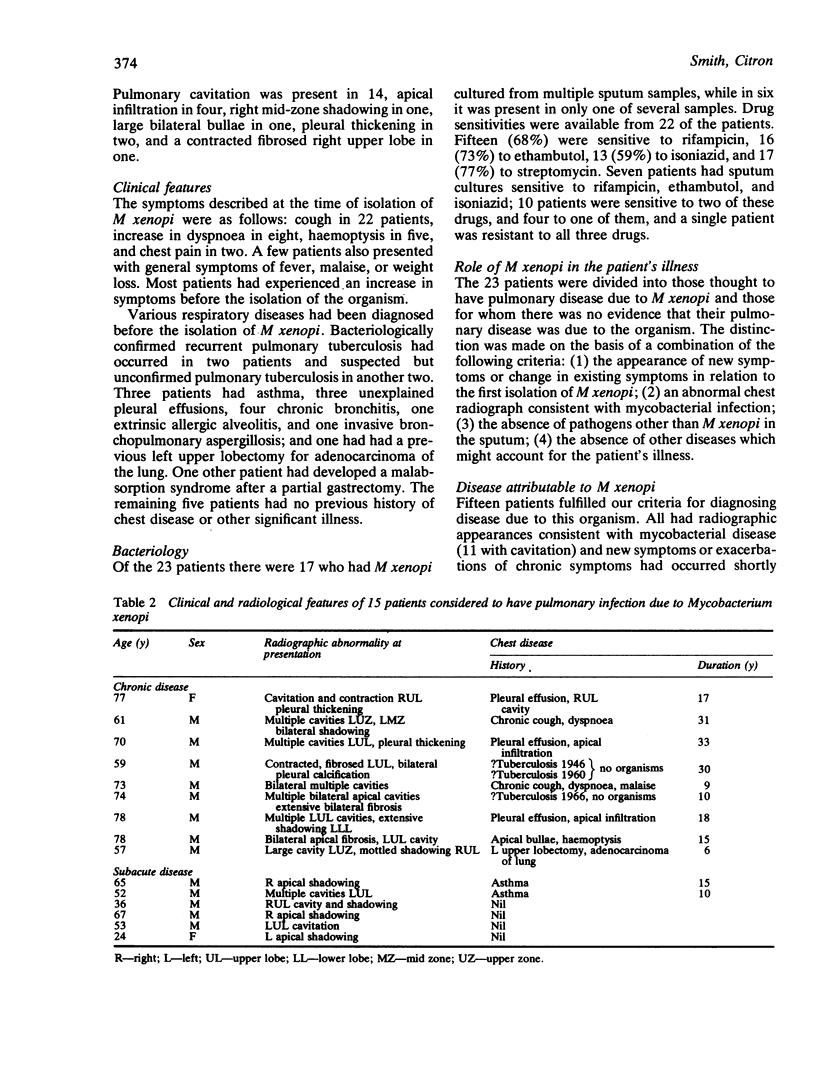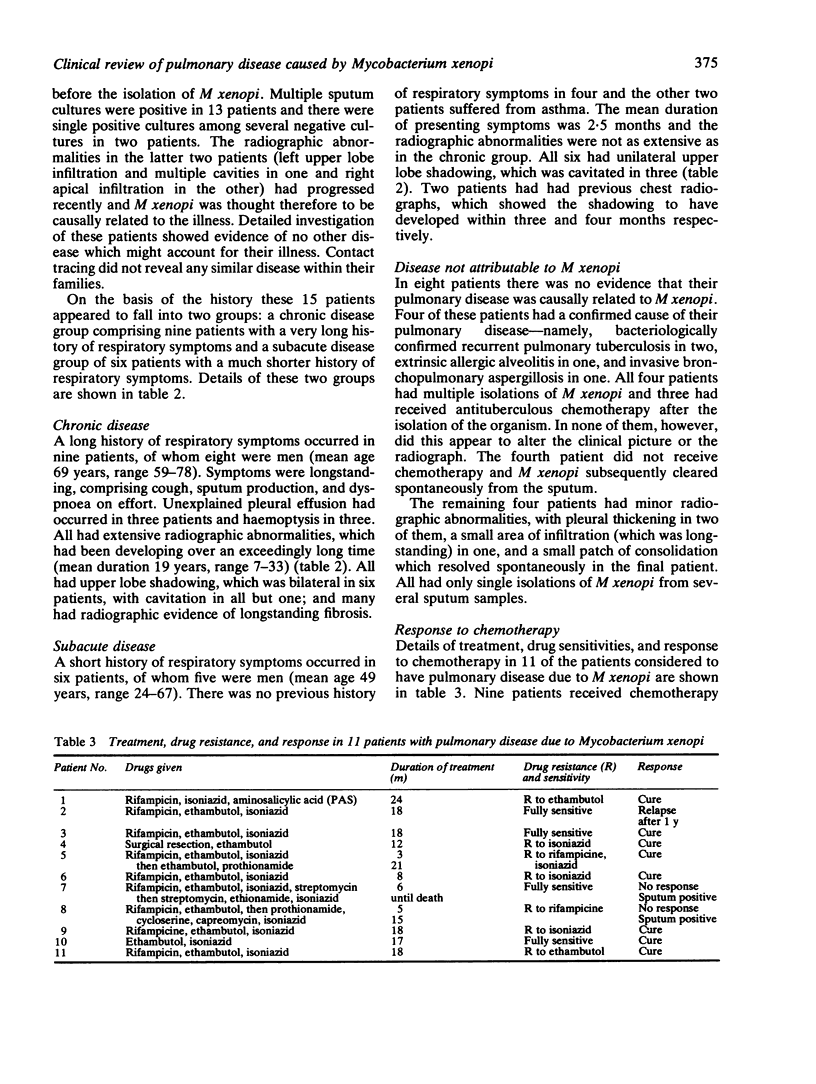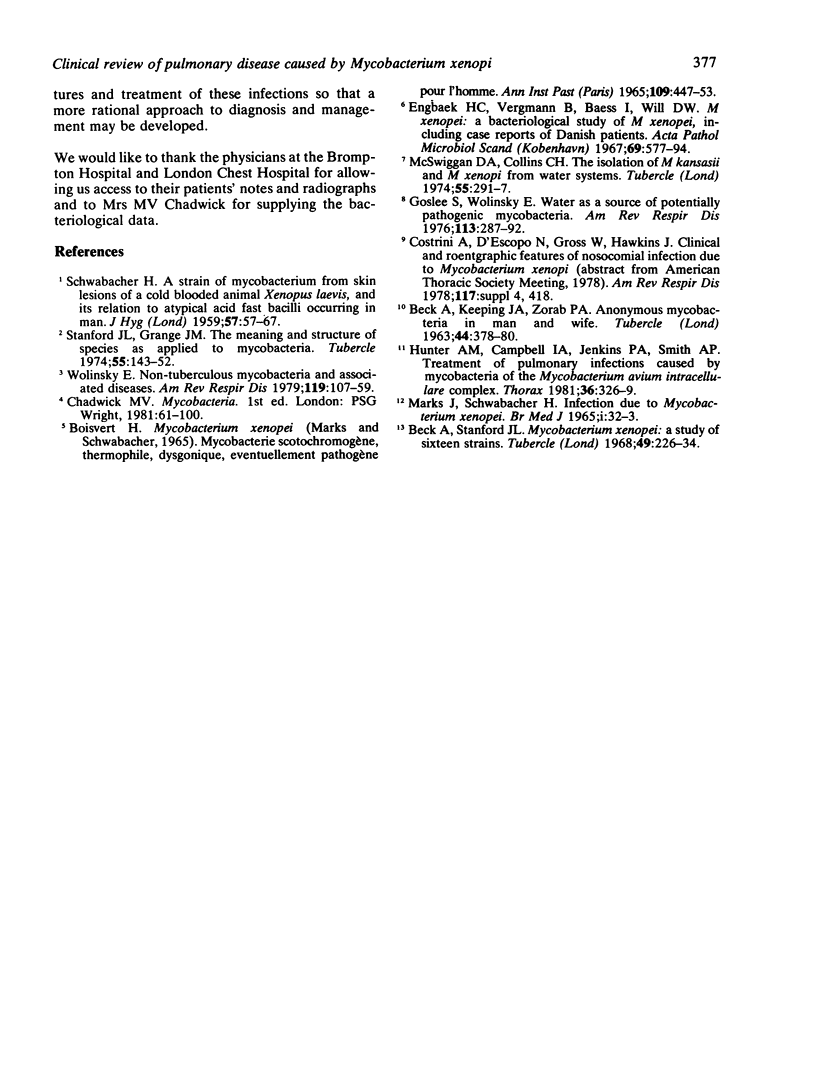Abstract
Mycobacterium xenopi comprised 56% of all non-tuberculous mycobacteria isolated in the Brompton Hospital laboratory during six years. M xenopi alone was cultured from the sputum of 23 patients, whose clinical and bacteriological features are reviewed. Pulmonary disease was considered to be due to the organism present in 15 of these patients on the basis of strict criteria for a causal relationship. Radiographs of all these patients were consistent with mycobacterial disease, showing pulmonary cavitation in 11, apical shadowing in three, and upper lobe fibrosis in one. In nine patients the disease was chronic, progressing very slowly with longstanding respiratory symptoms and extensive radiographic abnormalities developing over many years (mean 19 years). In six patients the disease was subacute, being of recent onset with radiographic shadowing of limited extent. M xenopi was isolated as a saprophyte from four patients who had lung disease of known cause and single isolates were obtained from four patients who had no lung disease attributable to this organism. In vitro drug sensitivity tests showed the sputum cultures of 17 of 22 patients to be sensitive to two or more of the drugs rifampicin, isoniazid, and ethambutol. Response to chemotherapy was unpredictable and did not always correlate with the results of sensitivity tests. Of 11 patients treated with at least two drugs to which their organisms were sensitive, two remained sputum positive, one relapsed after 18 months of chemotherapy, and eight have remained sputum negative during a minimum of three years' follow-up.
Full text
PDF




Selected References
These references are in PubMed. This may not be the complete list of references from this article.
- Beck A., Stanford J. L. Mycobacterium xenopei: A study of sixteen strains. Tubercle. 1968 Jun;49(2):26–34. doi: 10.1016/0041-3879(68)90025-1. [DOI] [PubMed] [Google Scholar]
- Boisvert H. Mycobacterium xenopei (Marks et Schwabacher 1965), mycobactérie scotochromogène, thermophile, dysgonique, éventuellement pathogène pour l'homme. Ann Inst Pasteur (Paris) 1965 Sep;109(3):447–453. [PubMed] [Google Scholar]
- Engbaek H. C., Vergmann B., Baess I., Will D. W. M. xenopei: a bacteriological study of M. xenopei including case reports of Danish patients. Acta Pathol Microbiol Scand. 1967;69(4):577–594. [PubMed] [Google Scholar]
- Goslee S., Wolinsky E. Water as a source of potentially pathogenic mycobacteria. Am Rev Respir Dis. 1976 Mar;113(3):287–292. doi: 10.1164/arrd.1976.113.3.287. [DOI] [PubMed] [Google Scholar]
- Hunter A. M., Campbell I. A., Jenkins P. A., Smith A. P. Treatment of pulmonary infections caused by mycobacteria of the Mycobacterium avium-intracellulare complex. Thorax. 1981 May;36(5):326–329. doi: 10.1136/thx.36.5.326. [DOI] [PMC free article] [PubMed] [Google Scholar]
- MARKS J., SCHWABACHER H. INFECTION DUE TO MYCOBACTERIUM XENOPEI. Br Med J. 1965 Jan 2;1(5426):32–33. doi: 10.1136/bmj.1.5426.32. [DOI] [PMC free article] [PubMed] [Google Scholar]
- McSwiggan D. A., Collins C. H. The isolation of M. kansasii and M. xenopi from water systems. Tubercle. 1974 Dec;55(4):291–297. doi: 10.1016/0041-3879(74)90038-5. [DOI] [PubMed] [Google Scholar]
- SCHWABACHER H. A strain of Mycobacterium isolated from skin lesions of a cold-blooded animal, Xenopus laevis, and its relation to atypical acid-fast bacilli occurring in man. J Hyg (Lond) 1959 Mar;57(1):57–67. doi: 10.1017/s0022172400019896. [DOI] [PMC free article] [PubMed] [Google Scholar]
- Stanford J. L., Grange J. M. The meaning and structure of species as applied to mycobacteria. Tubercle. 1974 Jun;55(2):143–152. doi: 10.1016/0041-3879(74)90008-7. [DOI] [PubMed] [Google Scholar]
- Wolinsky E. Nontuberculous mycobacteria and associated diseases. Am Rev Respir Dis. 1979 Jan;119(1):107–159. doi: 10.1164/arrd.1979.119.1.107. [DOI] [PubMed] [Google Scholar]


